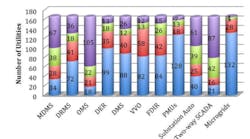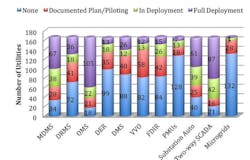Well, that’s a stupid question…..or is it? We hear about more “smart grid” technologies and applications on a regular basis. It is one of the most common subjects in the industry these days. Does that mean all grids are smart? Are they all equally smart or do some have PhD’s while others have associate degrees?
Penton Media, T&D World’s parent company, has conducted a lot of research in conjunction with ABB and other industry giants that is revealing or possibly reminding us of what is behind smart grid technology and the extent of its implementation. I’ll share some tidbits I’ve picked up in this column.
Most of us think of smart grids as T&D modernization efforts to incorporate digital technology that facilitates the collection, processing and exchange of information allowing interoperability and communication between connected devices. That is all true. There is a much longer official definition of the smart Grid in the Energy Independence and Security Act of 2007(see the Wikipedia version here: https://en.wikipedia.org/wiki/Energy_Independence_and_Security_Act_of_2007). The term defined in the law encompasses reliability, flexibility, efficiency, renewables, security and more.
So, what is behind the mysterious smart grid curtain? Well, we can definitively conclude it is not just a device or piece of electronic equipment that makes the grid smart. It is the combination of the piece of equipment or hardware and properly developed, coordinated and installed information and operation technology software that instills the smarts. That last step, the creation and/or application of functional, flexible, growth accommodating integration software, is performed by us….so it may sound a little corny, but it is we who make the smart grid smart.
Gene Wolf with T&D World Magazine wrote a masterful article regarding the ongoing evolution of the smart grid, its relationship to the Internet of Things (IoT) and now, the Internet of Things, Services and People (IoTSP).
People are referring to IoTSP, a recent phase of the evolution, where exchanges occur not only between machines, but also between customers and third parties in a market environment as “transactive energy” enablers. New York and several other states have developed or are working on policies for this new frontier of the distribution system platform provider (DSPP).
So we see the evolution of the grid occurring at a break-neck speed. This is the future. But, what if our utility or co-op is not on board yet? Not everyone is. Jason Dedrick from the School of Information Studies at Syracuse University recently shared survey results that reveal not all muni’s, co-ops and investor owned utilities he surveyed have implemented a large number of grid-side technologies, even the most common one which arguably is advanced meter infrastructure. Some entities are still studying the cost-benefits, evaluating their ability to recover the investment in rates or are held back by issues such as NERC-CIP v5 compliance or the perceived level of maturity of the technology. Accordingly, all grids are not smart, not yet anyway.
Likewise, Dedrick’s research shows us not all grids are equally smart. Some utilities have implemented numerous smart grid technologies, while others have implemented fewer technologies or implemented to a lesser extent. The following slide from a presentation by Professor Dedrick shows the level of deployment of various smart grid technologies.
My point, however, is that the critical consideration is not the number of sensors, controls or data storage components we add to our system when we decide to move ahead with smart grid applications. The focus also needs to be on mastering the integration of these systems, many times across traditional IT and OT lines, to allow them to achieve their potential for intelligence. Sounds easy, but this is the pixie dust in the equation. Peter Manos from Penton who conducted research on IT/OT integration surveyed utility CTOs and others who offered that new skills may be needed in organizations, new levels of interaction between departments may become necessary and sometimes the changes will be disruptive. Manos shared that regulatory and business models also may need to change going forward.
Thankfully, we do not have to embark on this journey alone. IEEE, the Gridwise Architecture Council, EPRI, NREL and NERC have policies and guidelines to help ensure we get the desired functionality from new systems and system integration. Many of our contemporaries are willing to share lessons learned and many experts in the field can guide us to hardware and software choices that will be more adaptable to changes and growth. The “smart” thing to do for those of us still on the fence may be to get on the bus, even if we start by just going around the block.



